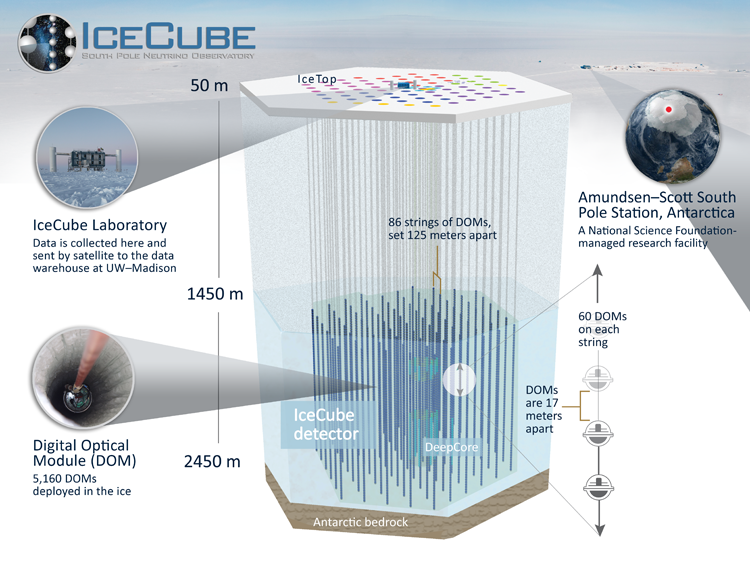For more than a century people have been studying cosmic rays from a huge variety of locations – from mountaintop observatories to detectors in the desert and deep seas, balloons and rocket flights, to orbiting satellites and the International Space Station.
But their origin has remained a puzzle.
Now, data from deep under the Antarctic ice may have finally helped pinpoint where they come from.
Cosmic rays are high-energy particles originating in space. They constantly strike the Earth’s atmosphere, creating showers of secondary particles.

So far, it’s proved very difficult to track down where cosmic rays come from.
As they travel across space their paths get warped by powerful magnetic fields, so by the time they strike Earth it’s impossible to figure out their trajectory.
Instead, scientists have been looking for clues from particles that are often produced alongside cosmic rays, but whose paths don’t get warped – neutrinos.
Neutrinos (the name means ‘little neutral one’) are created in violent cosmic events such as stellar explosions, colliding black holes or bursts of gamma ray radiation.
Often described as the ghosts of the particle world, they rarely interact with other matter and can travel for millions of years through space, passing straight through stars, planets and anything else in their path.
This straight-line travel makes them useful cosmic pointers, but they are fiendishly hard to detect. It takes extremely sensitive equipment, shielded from other confusing signals.
The world’s biggest and coolest (sorry, we couldn’t resist) neutrino detector is IceCube.
Buried in a square kilometre of Antarctic ice, IceCube is an array of 5,160 Digital Optical Modules, or DOMs.

When an incoming neutrino strikes an atom of oxygen or hydrogen in the ice it gives off a flash of light. This can be picked up by photomultiplier tubes within the DOMs, which send signals back to the surface for scientists to study.
Data from the grid of DOMs allow the direction of the neutrino’s travel to be reconstructed. The clever IceCube design means that the neutrinos travel through a very pure and transparent ‘lens’ of Antarctic ice, in which there are no other signals to interfere with the detection.

Now, IceCube has worked in tandem with a global network to pinpoint a neutrino from a cosmic event.
On 22 September 2017 a neutrino passed through the Antarctic ice, triggering IceCube’s alert system to set telescopes around the world scanning the skies for a high-energy event that might have created the passing ghost.
Data from the Fermi space telescope and MAGIC telescope in the Canary Islands identified a burst of gamma rays, extremely high energy radiation, in an area of sky near the shoulder of the constellation Orion.
The source was a blazar, about 4 billion light years away.
Blazars are enormous elliptical galaxies with massive spinning black holes at their cores. As the black holes spin, jets of light and particles are emitted towards Earth.
‘The evidence for the observation of the first known source of high-energy neutrinos and cosmic rays is compelling,’ says IceCube lead scientist Francis Halzen, of the University of Wisconsin–Madison.
There’s lots more work to do in finding out more about cosmic rays and what happens inside blazars, but the IceCube result shows that neutrinos could help to open up new windows on space.
Multimessenger astronomy, where observations of different sources such as neutrinos, cosmic rays and gravitational waves are closely coordinated, is starting to provide lots of rich data on the universe.
You can now see an IceCube DOM from our collection in the Tomorrow’s World gallery at the Science Museum.
All the modules were given names during testing by scientists at Uppsala University – this one was dubbed Rissla after small sleds that are used in Northern Sweden.
Rissla didn’t pass the tests to be used in Antarctica, but that meant the Wisconsin team were able to donate it to the Science Museum Group collection.